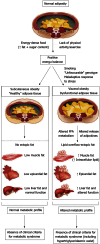What about non-alcoholic fatty liver disease as a new criterion to define metabolic syndrome?
- PMID: 23801829
- PMCID: PMC3683675
- DOI: 10.3748/wjg.v19.i22.3375
What about non-alcoholic fatty liver disease as a new criterion to define metabolic syndrome?
Abstract
Non-alcoholic fatty liver disease (NAFLD) is currently not a component of the diagnostic criteria for metabolic syndrome (MetS); however, the development of NAFLD has some common mechanisms with the development of MetS, as they share the pathophysiologic basis of insulin resistance. It is also recognized that NAFLD is the hepatic manifestation of MetS. To define MetS, the presence of at least three of the proposed criteria is required, and sometimes it is sufficient to have only one laboratory value, modified by diet or drugs, for the classification of MetS. Ultrasonographically-detected NAFLD (US-NAFLD) is more stable, only changing during the middle- to long-term. Although controversies over MetS continue, and considering that abdominal ultrasonography for diagnosing NAFLD has high specificity and guidelines to modify the natural course of NAFLD by diet composition or lifestyle have not yet been established, why should we not introduce US-NAFLD as a new criterion to define MetS?
Keywords: Criteria; Metabolic syndrome; Non-alcoholic fatty liver disease; Nonalcoholic steatohepatitis; Ultrasonography.
Figures
References
-
- Finelli C, Tarantino G. Is visceral fat reduction necessary to favour metabolic changes in the liver? J Gastrointestin Liver Dis. 2012;21:205–208. - PubMed
-
- Tarantino G, Colao A, Capone D, Conca P, Tarantino M, Grimaldi E, Chianese D, Finelli C, Contaldo F, Scopacasa F, et al. Circulating levels of cytochrome C, gamma-glutamyl transferase, triglycerides and unconjugated bilirubin in overweight/obese patients with non-alcoholic fatty liver disease. J Biol Regul Homeost Agents. 2011;25:47–56. - PubMed
-
- Tarantino G, Finelli C, Colao A, Capone D, Tarantino M, Grimaldi E, Chianese D, Gioia S, Pasanisi F, Contaldo F, et al. Are hepatic steatosis and carotid intima media thickness associated in obese patients with normal or slightly elevated gamma-glutamyl-transferase? J Transl Med. 2012;10:50. - PMC - PubMed
-
- Colicchio P, Tarantino G, del Genio F, Sorrentino P, Saldalamacchia G, Finelli C, Conca P, Contaldo F, Pasanisi F. Non-alcoholic fatty liver disease in young adult severely obese non-diabetic patients in South Italy. Ann Nutr Metab. 2005;49:289–295. - PubMed
-
- Lazo M, Clark JM. The epidemiology of nonalcoholic fatty liver disease: a global perspective. Semin Liver Dis. 2008;28:339–350. - PubMed
Publication types
MeSH terms
Substances
LinkOut - more resources
Full Text Sources
Other Literature Sources
Medical


